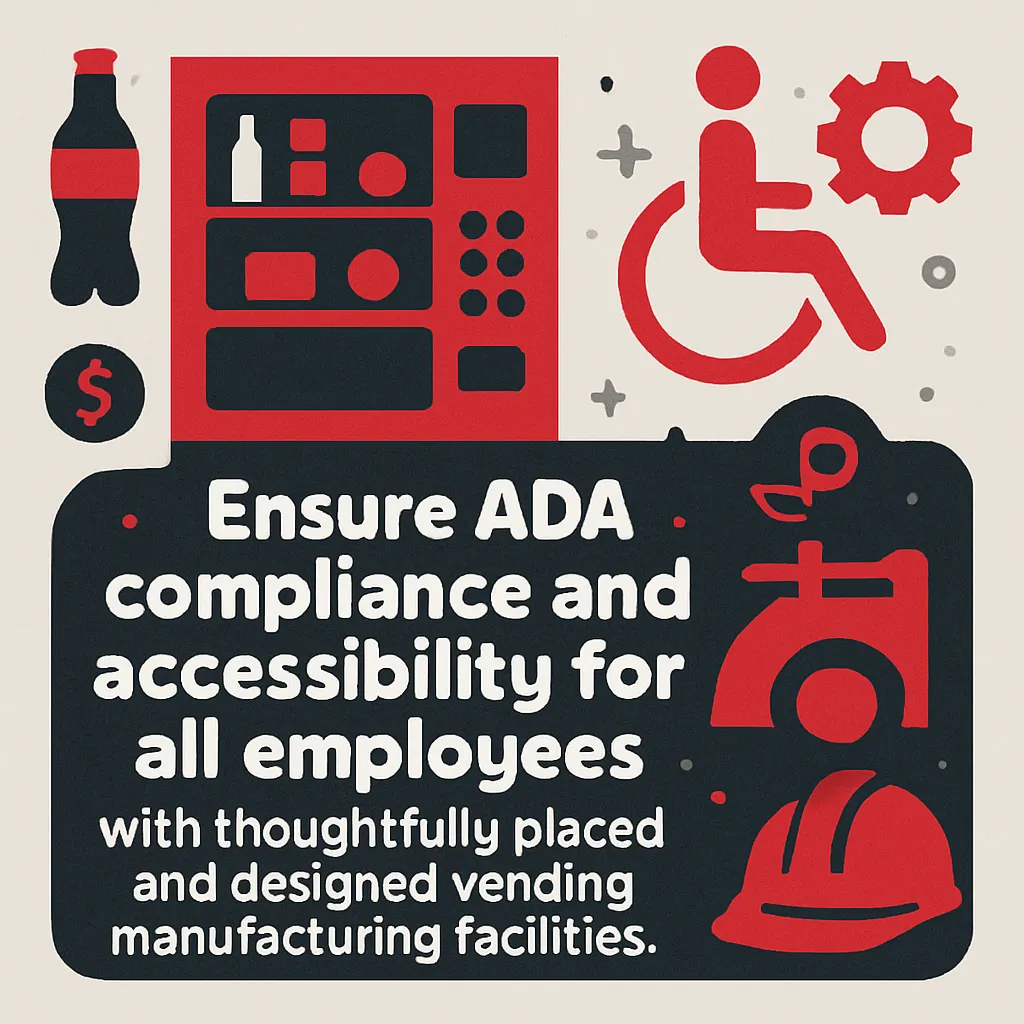Accessibility Standards for Vending in Factories (ADA)
Ensure ADA compliance and accessibility for all employees with thoughtfully placed and designed vending machines in manufacturing facilities.
Back to Vending for Manufacturing ResourcesEnsure ADA compliance and accessibility for all employees with thoughtfully placed and designed vending machines in manufacturing facilities.
Back to Vending for Manufacturing ResourcesAdhering to ADA standards for vending machines in manufacturing facilities goes beyond legal obligation, fostering an inclusive environment where all employees can access refreshments comfortably and independently.
![]() Accessible reach ranges for controls and product retrieval
Accessible reach ranges for controls and product retrieval
![]() Clear floor space for easy wheelchair maneuverability
Clear floor space for easy wheelchair maneuverability
![]() Operable mechanisms requiring minimal force and no tight grasp
Operable mechanisms requiring minimal force and no tight grasp

For any manufacturing facility, ensuring that all employees have equitable access to essential services is paramount. This includes convenient access to refreshments and snacks through vending machines. The Americans with Disabilities Act (ADA) sets forth crucial guidelines to guarantee that these services are accessible to everyone, including individuals with disabilities. Proper planning and selection of vending equipment play a vital role in creating an inclusive factory environment.
When integrating vending machines into a factory, several ADA standards must be met. These typically include specifications for reach ranges (both high and low), clear floor space for wheelchair maneuverability, and operable controls that do not require excessive force or fine motor skills. For instance, the highest operable part of a control should be within a certain vertical reach, and the lowest dispensing point must also be within an accessible range. Compliance ensures that all workers, regardless of physical ability, can independently use the machines.
Beyond the technical specifications, consider the path of travel to the vending machines. Are they located on an accessible route, free from obstructions, and easy to navigate for someone using a mobility aid? This holistic approach to accessibility ensures convenience for all. Understanding these critical standards can go a long way in ensuring your facility is inclusive. Detailed information on equipment durability for industrial settings can be found in resources like Equipment Durability for Industrial Vending.
Implementing ADA-compliant vending machines offers numerous benefits. First and foremost, it demonstrates a commitment to employee well-being and fosters a more inclusive workplace culture. When all employees feel supported and have equal access to amenities, morale and productivity can improve. Furthermore, compliance minimizes legal risks and potential penalties associated with ADA violations.
Modern vending technology also emphasizes accessibility. Many new machines feature larger, more tactile buttons, touchless payment options, and clear visual displays that benefit a wide range of users. For factories with diverse workforces, these features are invaluable. To further enhance employee morale and productivity, consider exploring Vending Services for Manufacturing Plants.
Ensuring that vending areas are well-lit and maintained also contributes to overall accessibility and safety. The commitment to ADA standards in factory vending areas reflects an organization's dedication to creating a truly accessible and supportive environment for all its employees. You can also explore how to incorporate healthy options by reviewing Healthy Vending for Factory Workers.
ADA requirements for vending in factories primarily focus on reach ranges, operability, and clear floor space to ensure accessibility for individuals with disabilities.
For a forward approach, the maximum high reach is 48 inches (1220 mm). For a side approach, it's 54 inches (1370 mm), but this also assumes an obstruction-free reach over a maximum 10-inch deep counter.
A clear floor space of at least 30 inches by 48 inches (760 mm by 1220 mm) is required in front of an accessible vending machine to allow for a forward or parallel approach by a wheelchair user.
While not every single machine needs to be compliant, a reasonable number or percentage should meet ADA standards to ensure accessible options are available to all employees.
Operating mechanisms must be operable with one hand and not require tight grasping, pinching, or twisting of the wrist. The force required to activate them should be no more than 5 pounds (22.2 N).
While not strictly mandated for all vending machines, providing visual displays in high contrast and auditory feedback can greatly enhance accessibility for employees with visual or hearing impairments.
Accessible vending machines must be located on an accessible route. This means the path leading to the machine must be free of obstructions, stairs, or other barriers for wheelchair users.
Consider machines with clearly labeled selections, large buttons, easy-to-reach product delivery, and payment interfaces that accommodate various abilities.
Yes, micro markets in factories must also adhere to ADA accessibility guidelines, including accessible pathways, checkout kiosks, and reach ranges for product displays.
Beyond legal compliance, it fosters an inclusive work environment, improves employee morale, and ensures all staff members have equitable access to refreshments.